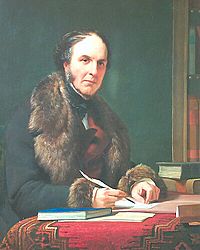Royal Commission into the Operation of the Poor Laws 1832 facts for kids

The 1832 Royal Commission into the Operation of the Poor Laws was a group set up to decide how to change the Poor Law systems in England and Wales. The group included Nassau Senior, a professor from Oxford University who was against the allowance system, and Edwin Chadwick, who was a Benthamite. The recommendations of the Royal Commission's report were implemented in the Poor Law Amendment Act 1834.
Contents
Formation
On 1 February 1832, the formation of the Royal Commission was announced by Viscount Althorp in the House of Commons. The Royal Commission consisted initially of seven commissioners and sixteen assistant commissioners. The central board was expanded to nine commissioners in 1833. The assistant commissioners were to be sent out into England and Wales to collect data on poverty by visiting parishes and by having persons respond to questionnaires, and the central board would digest the information into a report.
The findings of the Poor Law Commissioners, published in thirteen volumes, began appearing in February 1833. They were used to argue that the existing system of poor relief needed a radical overhaul.
Members
The nine members of the Central Board of the Commission were:,
- Charles James Blomfield (Bishop of London) - Chairman
- William Sturges Bourne (chairman of the 1817 Parliamentary commission)
- John Bird Sumner (Bishop of Chester)
- Nassau Senior
- Walter Coulson
- Rev. Henry Bishop, a fellow of Oriel College, University of Oxford.
- Henry Gawler
- James Traill
- Edwin Chadwick (secretary)
The first seven were appointed in 1832, the last two in 1833.
Recommendations
The writers of the report suggested radical changes to English Poor Laws:
- Separate workhouses for different types of paupers including aged, children, able-bodied males and able-bodied females.
- The grouping of parishes into unions to provide workhouses.
- A ban on outdoor relief so that people had to enter workhouses to claim relief
- A central authority to implement the policies and to prevent the variation that in practice occurred under the Old Poor Law.
Criticism
There is evidence that Nassau Senior had written the report before the data was collected and that evidence was used selectively to meet the prewritten report. Of the questionnaires sent out, only 10% replied, and some of the questions directed a certain response. However, the inquiry was not supposed to be impartial since the commission wanted to change the existing system, and keeping the current system was not considered an option. The questionnaires used asked leading questions, which were poorly framed and led to responses that were ambiguous or irrelevant.
From a modern standpoint, it can be argued that despite the long term effects of the ensuing Poor Law Amendment, the report itself was wildly inaccurate. Most of the relief was received by the underserving poor (those who were considered not "able-bodied" and therefore underserving of poverty), which contrasted with the reports findings. Only 20% of the total population of 12 million were claiming poor relief, of which only 20% were "able-bodied", 50% were children under 5 and 9% to 20% were sick, aged or infirm. Many of the moral judgements that supported Benthamite ideas were thus unfounded.
"They fell into the trap of assuming that employers and workers could bargain on equal terms, which they could not and did not. The Commissioners argued that the existing means of poor relief allowed unscrupulous employers and farmers to force down wages and deliberately to keep a pool of surplus labour because they knew the workers could 'fall on the rates' if it suited business. It was accepted that poverty was inevitable ("the poor are always with you') so nothing was done to tackle that problem. It was thought that a deterrent workhouse would cause a moral reformation among the poor: that they would go out and find work rather than submit to 'the House'. Unfortunately, there was little work to be found in the rural south so the whole basis of the legislation was unsound." Marjie Bloy, Ph. D.
Sources
Bryan Green. Knowing the Poor. A Case Study in Textual Reality Construction. London: RKP, 1993

